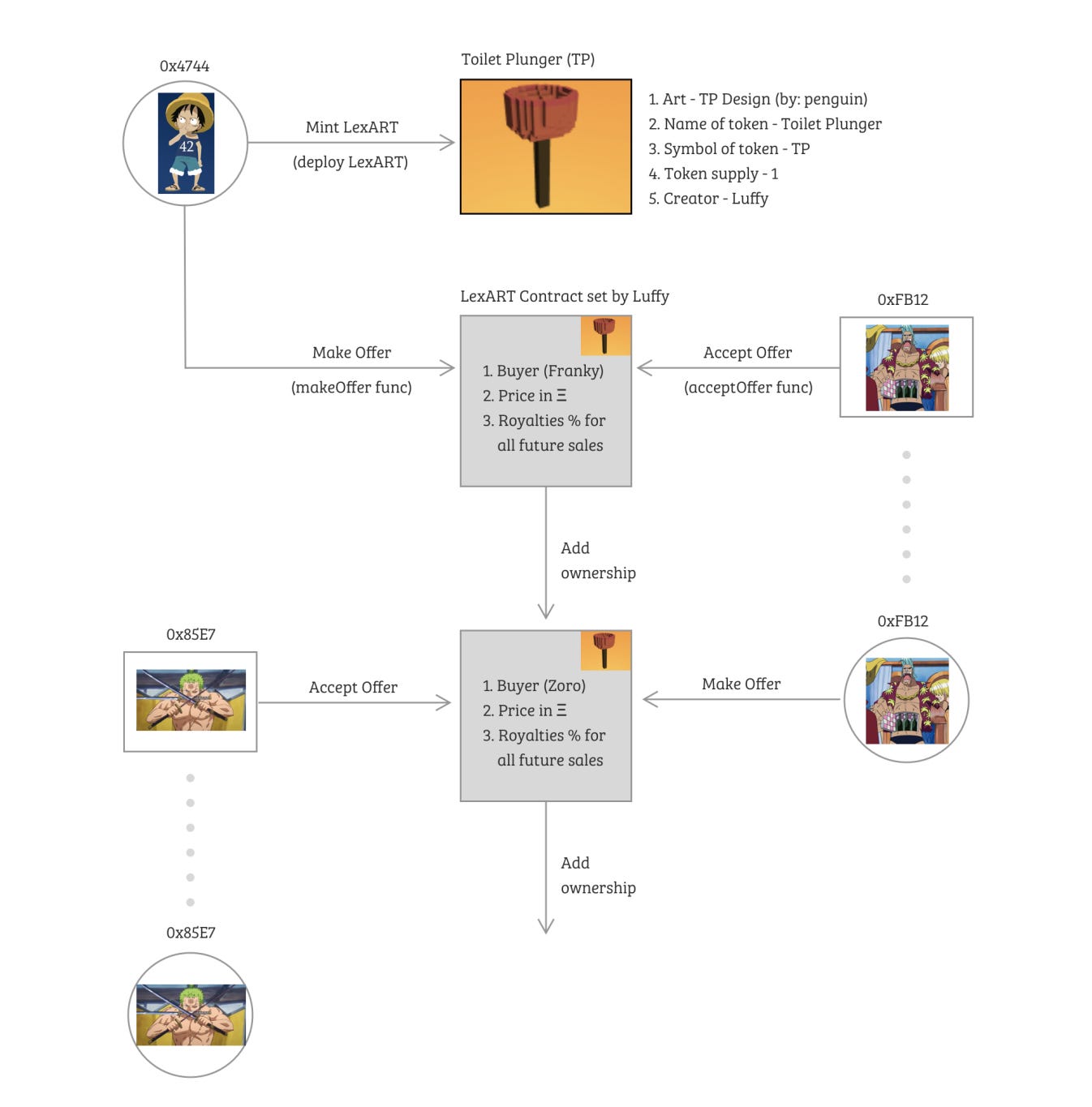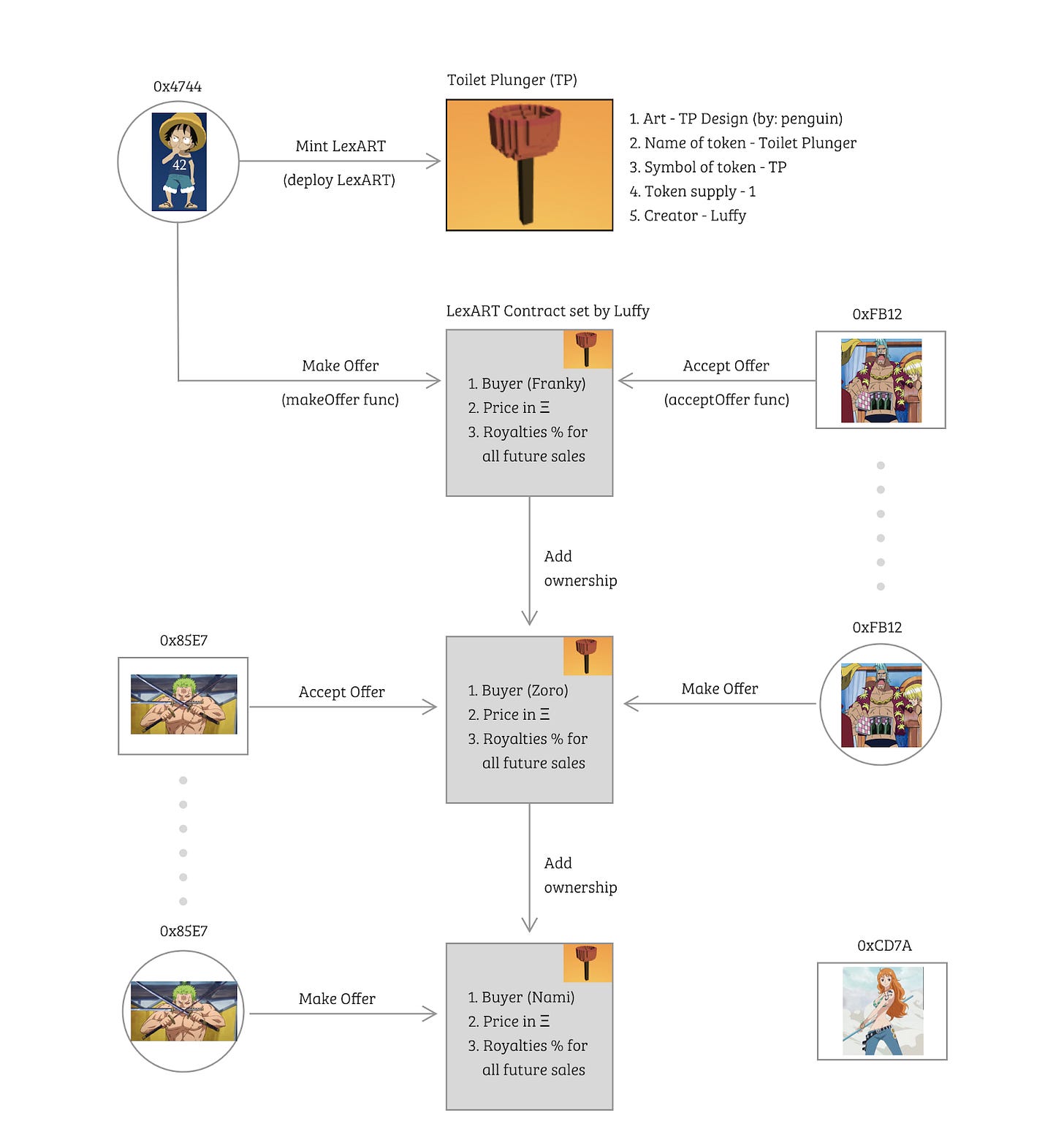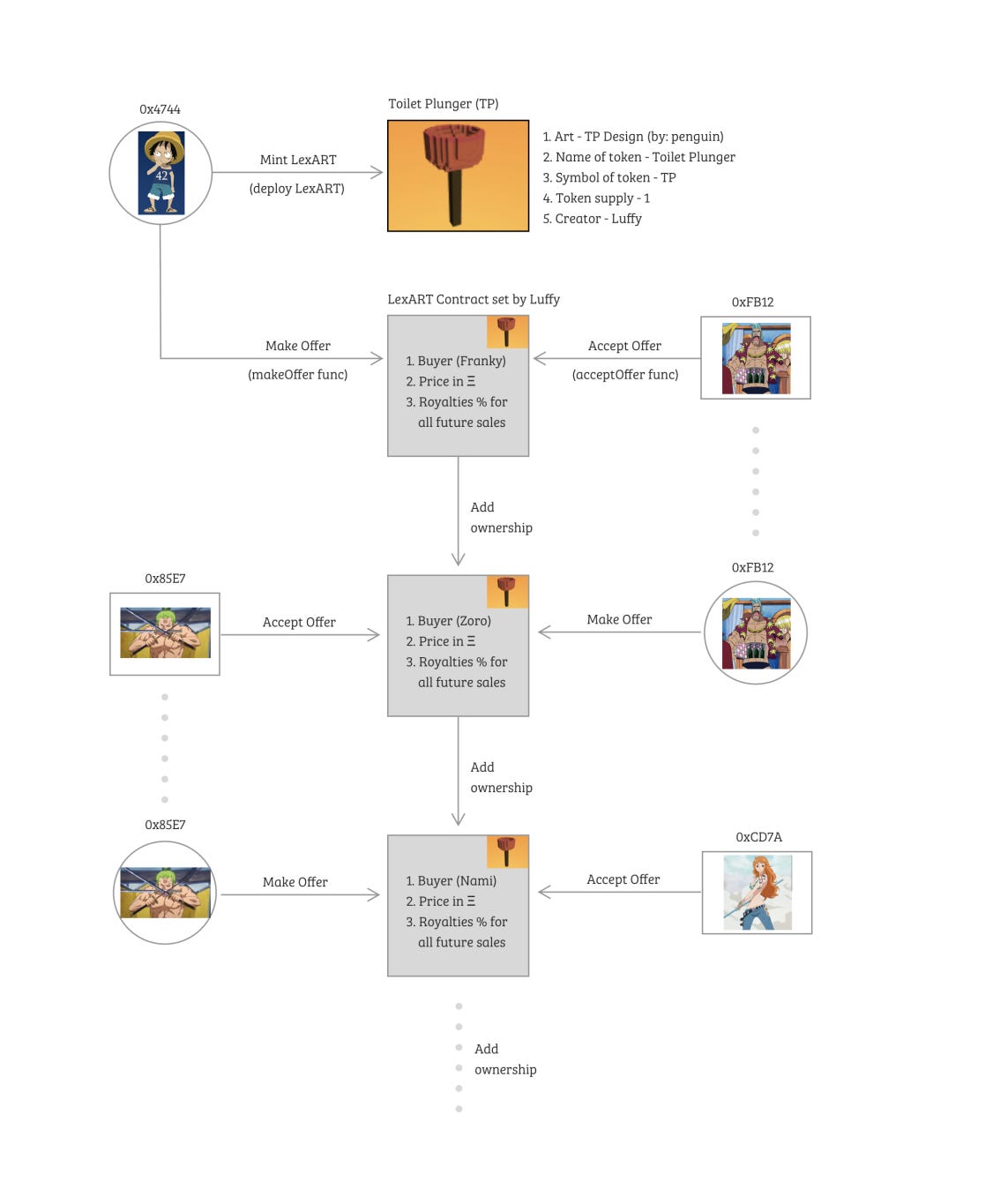LexART
Preface
This is the first of a series of learnings as I dig deeper into the cryptoart space. This journey started when I joined LexDAO and became a ⚔️ legal engineer ⚔️. Through LexDAO, I learned to program reality, as Ross aptly puts it, with smart contracts.
With what basic knowledge I gathered re solidity programming, I figured I’d try to apply intellectual property laws programmatically to unique creative human creations.
LexART
“[the United States Congress shall have power] To promote the progress of science and useful arts, by securing for limited times to authors and inventors the exclusive right to their respective writings and discoveries.” - Article I, Section 8, Clause 8 of the U.S. Constitution
This clause is the basis for both copyright and patent laws in the U.S. In reality, whether this clause actually “promote[s] the progress of science and useful arts” is subjective. Different stakeholders hold different perspectives; progress as measured by capitalistic means is one way to do it. So I wondered how “securing for limited times to authors and inventors” can be done or improved via Ethereum to achieve this purpose. And so the LexART experiment began.
LexART aims to be a programmatic collector token for unique human creations. The purpose of LexART is to help creators retain authorship and receive, along with collectors, royalties on future sales. Code for LexART can be found here.
In relation to Clause 8, LexART thus far can publicly secure authorship forever through Ethereum, IPFS, and Arweave (in theory) and programmatically withhold some exclusive rights for the creator. LexART is really just another experiment.
Flow
Step 1 (Etherscan)

We start with Luffy, the protagonist of One Piece. Luffy is the captain of the Straw Hat Pirates. He stumbles upon some cool design created by penguin and decides to tokenize it. He mints a Toilet Plunger token (TP) by deploying the LexART smart contract with the obligatory name, symbol, etc. TP is unique. It’s an ERC20 token with supply capped at 1.
Luffy originally intended to use TP to design the best toilet plunger ever to keep the pirate ship clean. But he had grander dreams with little time to spare, so he decided to sell it to his crew member, Franky. Franky is Iron Man but uses Coke as fuel. Luffy thought the design would be helpful for coming up with new weapons.
Step 2

Luffy makes an offer by specifying the (1) buyer (i.e., Franky), (2) price in Ξ (i.e., 100 wei), and (3) how much he’s retaining from the future transactions of TP (i.e., 10%). Luffy makes the offer by accessing the makeOffer function.
Step 3 (Etherscan)

By specifying (1) - (3), only Franky can access the acceptOffer function with the correct Ξ. Other members are annoyed but they can’t do anything about it. Franky gladly pays 100 wei and is now the first collector of TP.
Step 4
Franky tried numerous times making a fancy weapon out of the toilet plunger design but was not successful. He grew frustrated but was confident that the design would prove beneficial for other members. So he went and found his buyer, Zoro. Franky accessed the makeOffer function and made an offer to Zoro for 100 wei in exchange for the TP token. Franky also retained 10%.
Step 5 (Etherscan)

Zoro is a swordsman that practices the art of fighting with three swords. He is so good that he’s sliced through metals. Out of boredom, Zoro thought it’d be fun to practice slicing with a toilet plunger, but he didn’t know what a toilet plunger looked like, so he accepted the offer from Franky.
Step 6

Zoro eventually figured out that toilet plunger is useful only if it is made of rubber. With much regret, he went out and found Nami as his buyer. Zoro accessed the makeOffer function and inputted Nami and 100 wei. Zoro likewise retained 10%.
Step 7 (Etherscan)

Nami, the proud holder and user of Clima-Tact, is practicing the art of weather manipulation.
She wanted to buy the toilet plunger design to help with pushing against liquids in battle. She accepted the offer from Zoro.
You get the idea. Creator mints a LexART token, makes an offer using the token, and collects royalties with the same token. Buyer accepts the offer, becomes a collector, and collects royalties with the creator.
Royalties
With the general flow outlined, we can now take a look at how creators and collectors benefit from future transactions.
Franky accepts Luffy’s offer

By accepting the offer, Franky’s payment of 100 wei is split into 2 categories: art payment and creator’s royalty. In this case, because Luffy sets 10% in (3) in step 2 of Flow, the 100 wei payment is split into 90 wei for art payment and 10% for royalties.
90 wei for art
+ 10 wei for creator’s royalty to Luffy
---------------------------------------------------------------
100 wei payment from Franky to Luffy
Zoro accepts Franky’s offer

Zoro accepts Franky’s offer, his payment has the following breakdown:
80 wei for art
10 wei for collector’s royalty to Franky
+ 10 wei for creator’s royalty to Luffy
---------------------------------------------------------------
100 wei payment from Zoro to Franky
Nami accepts Zoro’s offer

Nami accepts Zoro’s offer, her payment has the following breakdown:
70 wei for art
10 wei for collector’s royalty to Zoro
10 wei for collector’s royalty to Franky
+ 10 wei for creator’s royalty to Luffy
---------------------------------------------------------------
100 wei payment from Zoro to Franky
And so on.... This is a simple example where royalties have been set to 10% and each flip is keyed to 100 wei.
More experiments can be found in this sheet, where I tweak collector royalties % and flip multiple per sale. Based on the outcome, it seems that having a decaying collector royalties % would make sense, irrespective of what the flip multiple is.
When flip multiple is consistently lower (first sale: $100, second sale: $111, flip multiple: 1.11), creators will receive more value exchanged than that of any other collector for at least 10 cycles of transactions. When flip multiple is consistently higher (first sale: $100, second sale: $200, flip multiple: 2), creators can retain the same for at least 7 cycles. When flip multiple is consistently highest (first sale: $100, second sale: $500, flip multiple: 5), creators retain at least 8 cycles.
Reflect
Ultimately, the goal is to retain authorship and royalties for those that grow the communities for unique human creations. Much is still WIP. The next post will be about comparing royalties structure across platforms, e.g., Async Art, SuperRare, RareArt, etc.

